Swapping jobs in the nation’s capital for a tree change to the high country and a shed with a view on a rural property, Fiona and Alex moved to Fitzgerald’s Mount near Bathurst in 2008. There they built a house and created a garden that flourishes despite the harsh conditions of the high country of the central tablelands of NSW.
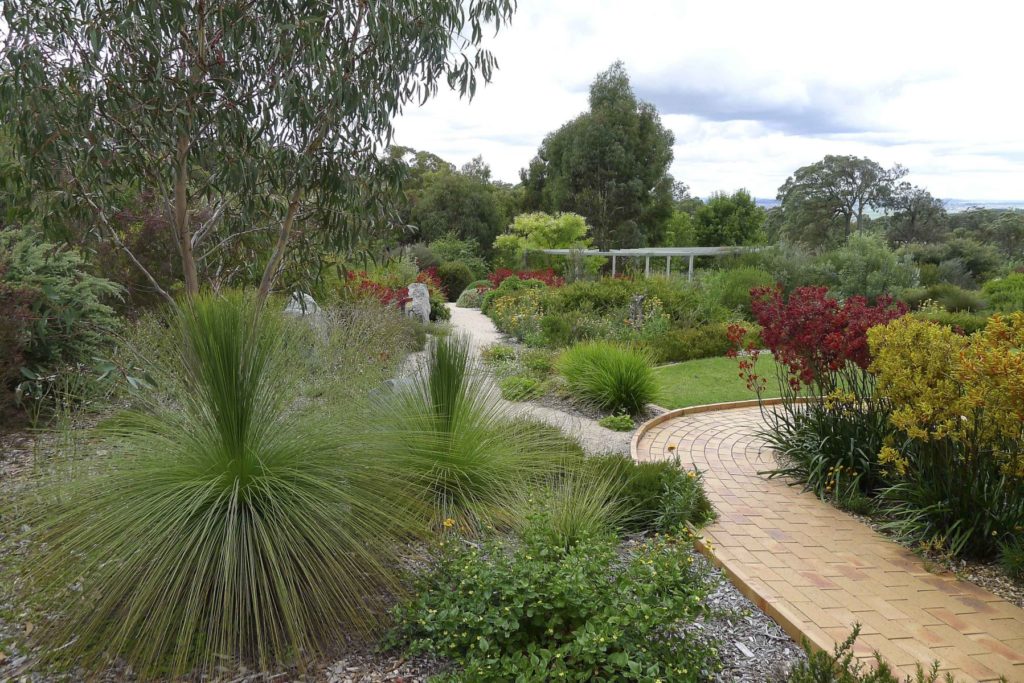
The property, a greenfields site, had good dams, a good balance of cleared spaces and treed areas, about 600 mm of rain each year and mostly clay soils. At nearly 1000m above sea level, it also has four seasons. And what seasons they are, with baking heat, vicious winds, snow and frost along with those cool, mild, balmy days of spring and autumn.
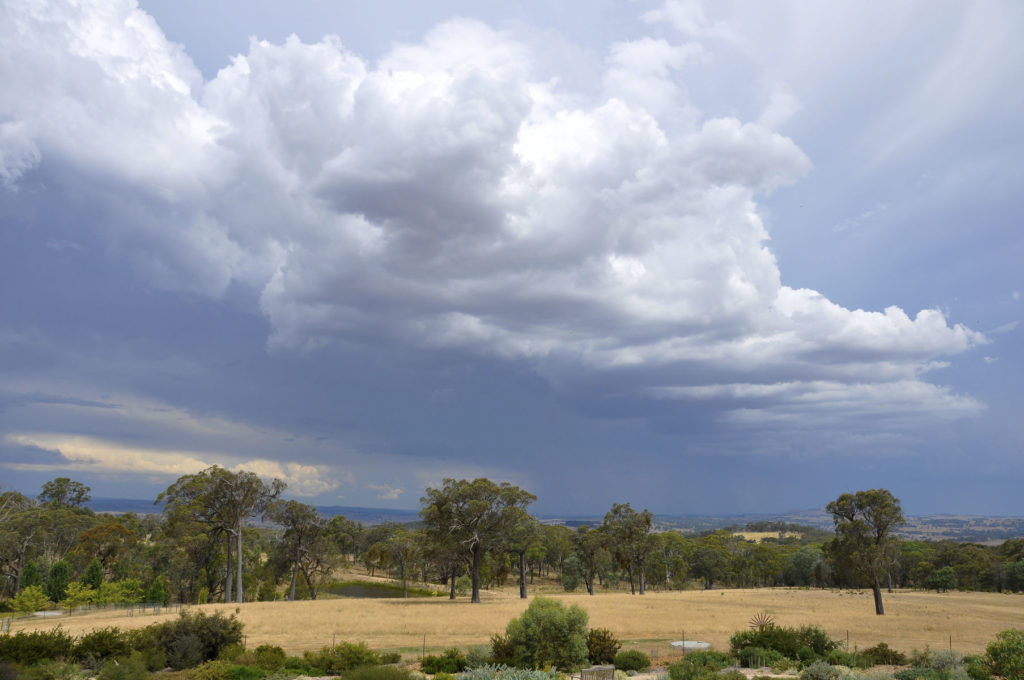
Design objectives
Notwithstanding the challenges, Fiona and Alex set ambitious goals for their garden:
• Create a garden for wildlife and aesthetics, complementing the house and landscape
• Use minimal herbicides and pesticides
• Actual gardening required, not just keep something tidy
• Retain the views
• Be a pleasant place to stroll with a glass of wine at the end of the day
• Enjoy from within the house during winter hibernation.
Initial plantings of exotic trees were not successful and so a switch to Australian natives was made. Fiona remembers her time as a child exploring the local bush with her mum, and has a natural affinity with natives. Her blended garden includes an extensive native garden along with an exotic cottage garden near the house and orchard.
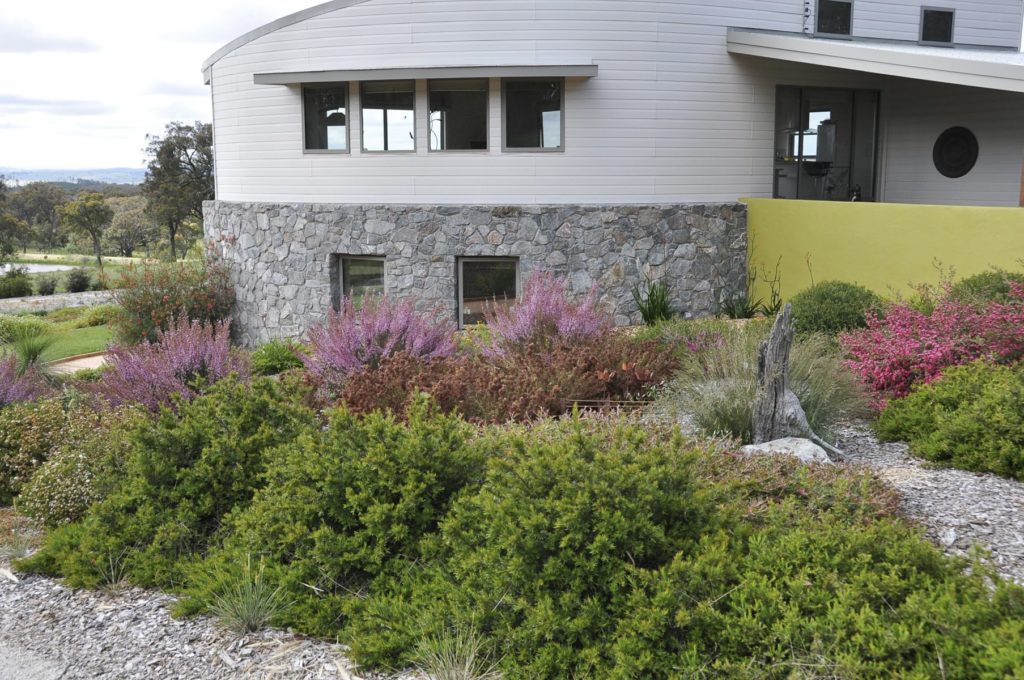
Drawing on her diary, here are Fiona’s reflections on a year in the life of her garden.
SPRING – rainbows of massed colour
Spring finally! Winter overstayed its welcome with unusually heavy frosts (and snow) and the cold weather lingered longer than was usual. But at last, spring is in the air bringing rainbow-like flushes of colour.
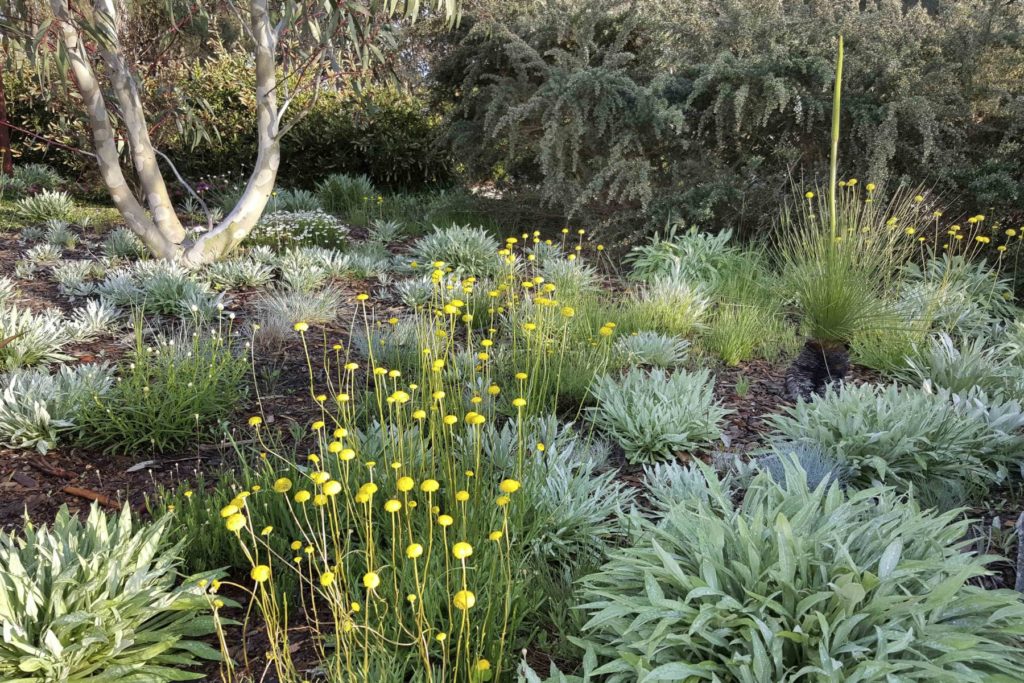
Early on, the violet/indigo pea flowers of Hovea dominate, followed by the yellow of wattles (Acacia) and billy buttons (Chrysocephalum apiculatum). Then a wave of white with the Philotheca wax flowers, and pinks with tea trees (Leptospermum) and bottle brushes (Callistemon). Purple makes its entry as the melaleucas awake and then the reds and golds of the kangaroo paws give us colour for months!

My favourites include the soft colours of Leptospermum ‘Jervis Bay’ and the delicate pinky white flowers of Pimelea spectabilis and Pimelea sylvestris. Among the stronger pinks, Eremophila ‘Yana Road’, Isopogon formosus and Leptospermum ‘Silver Fantasy’ standout.
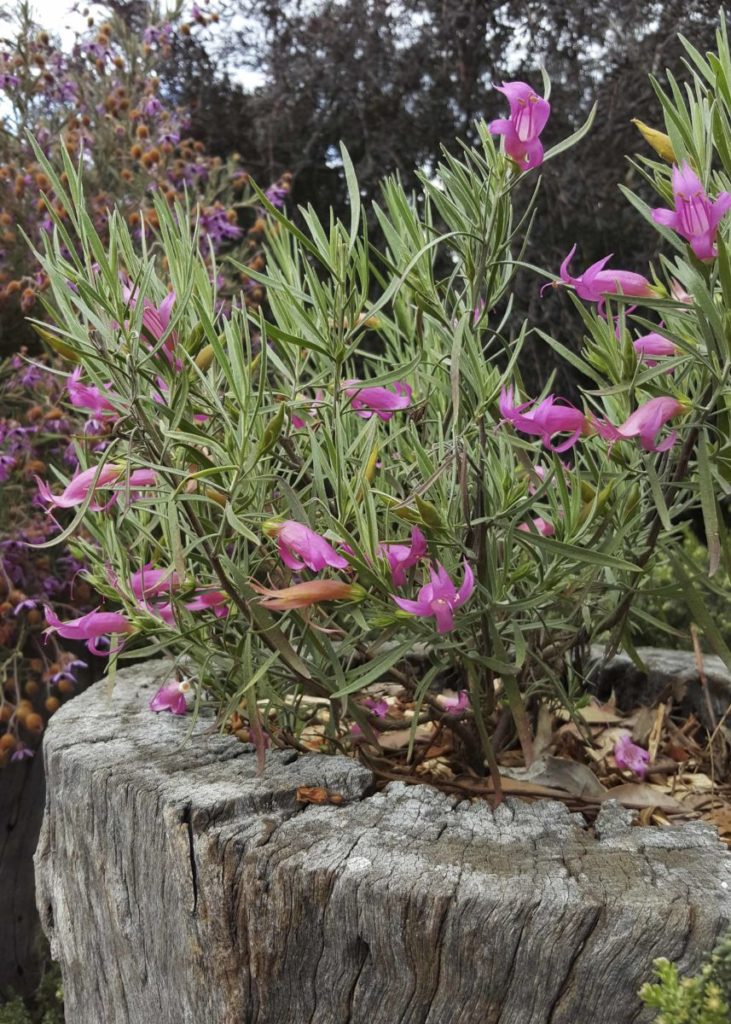
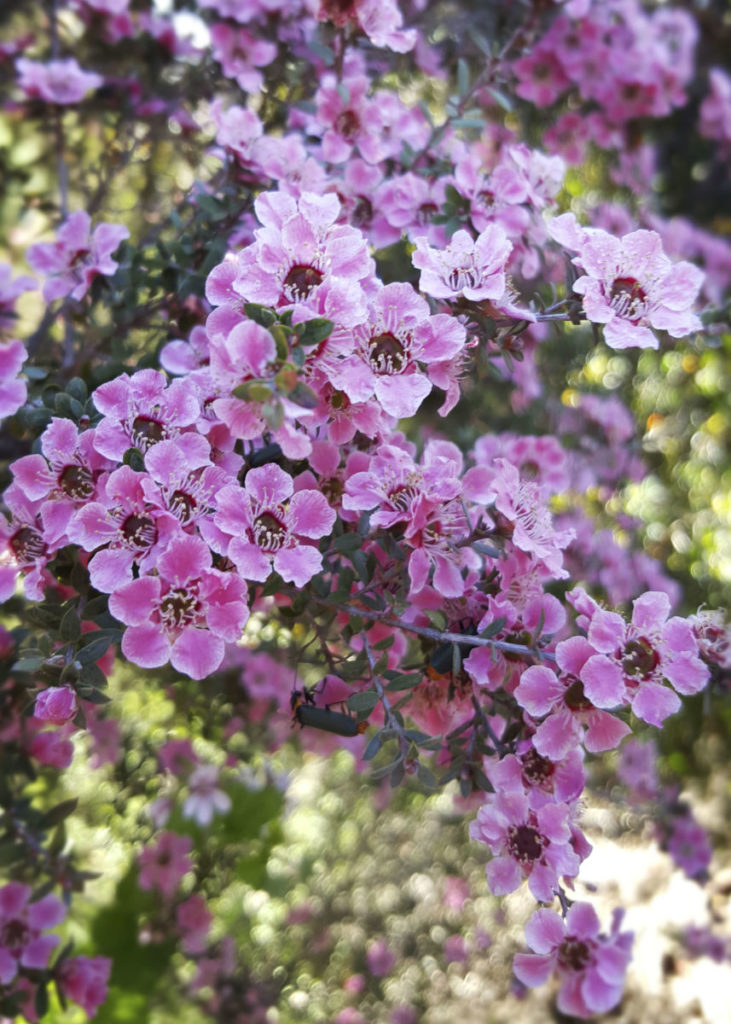
Earlier in the season Grevillea flexuosa had rich creamy yellow flowers with the added bonus of beautiful perfume. The Rylstone form of Persoonia chamaepitys has rich green pine-like foliage with bright orange flowers, a delightful combination.

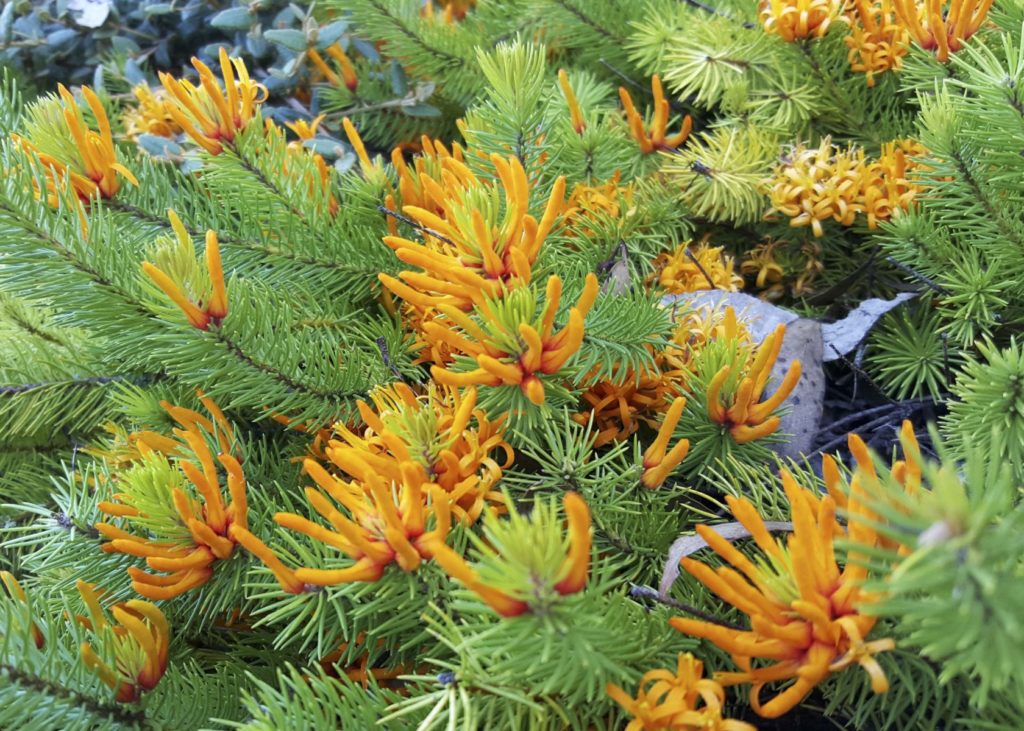
SUMMER - subtle colours with exquisite flowers, foliage and form
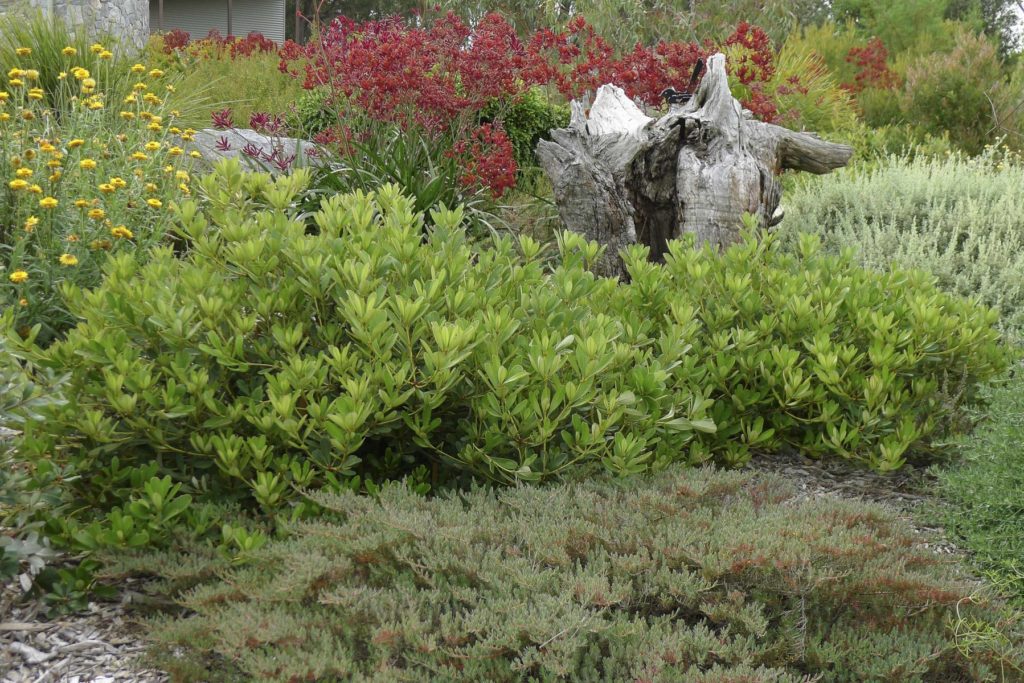
The red, orange and yellow Anigozanthos (kangaroo paw) hybrids, under-planted with yellow paper daisies (Xerochrysum bracteatum) cultivars, backed by the grey rock or green wall of the house, is striking. And once you realise just how many Eastern spinebills are foraging in the kangaroo paws at any one time, it’s hard to imagine a better result.
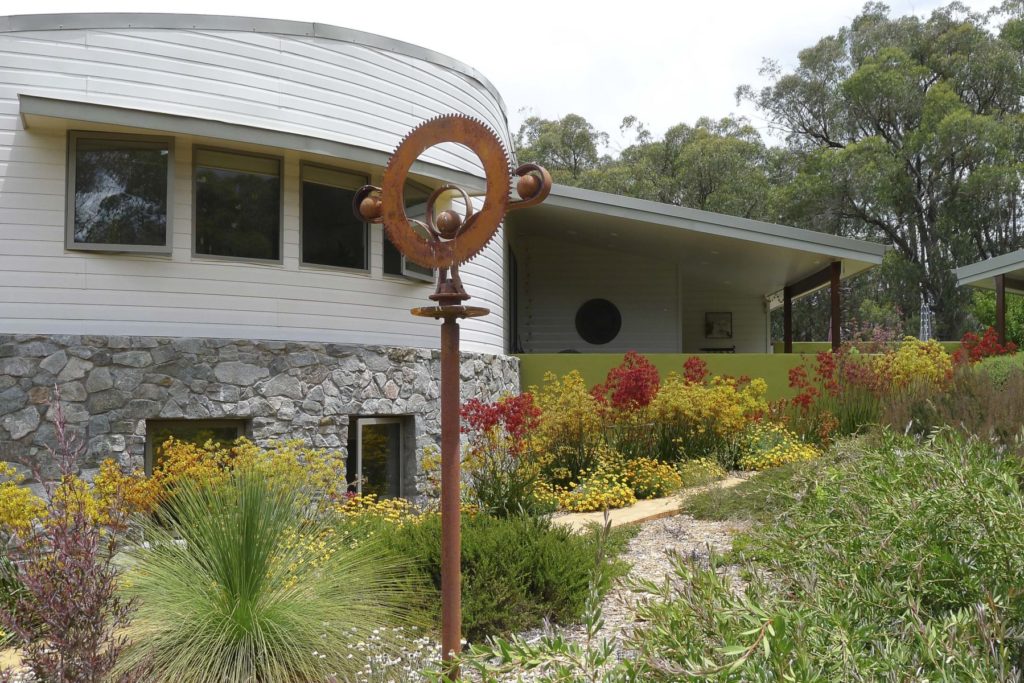
Subtle colour is found in the prostrate forms of Eremophila glabra and the Crowea exalata hybrids. The croweas range from white to deep pink, with a variety of foliage forms – fine burgundy-tinged foliage to larger, broader and brighter green leaves. Most correas are forming buds with only Correa glabra and a hybrid of Correa ‘Dusky Bells’ and Correa procumbens flowering. Derwentia arenaria, Babingtonia (syn. Baeckea) varieties and the pink, perfumed Goodenia macmillanii are lovely now. Banksia flower spikes are starting to develop, particularly on the Banksia spinulosa varieties.
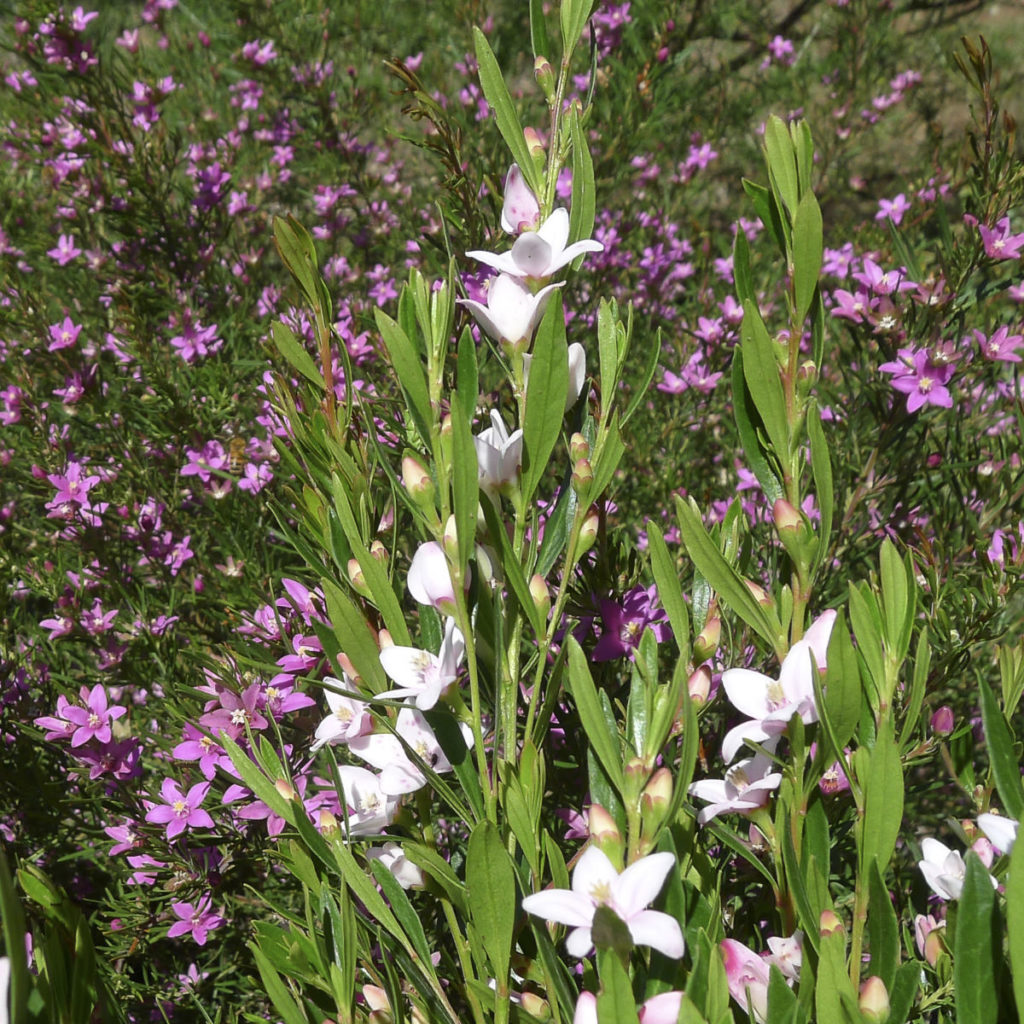
Summer is the time for the persoonias. Persoonia pinifolia takes on glorious burgundy tones in the colder months, but is now a rich green with yellow flowers starting to cover the bush. Persoonia pinifolia x juniperina shrubs are covered with tiny yellow flowers.
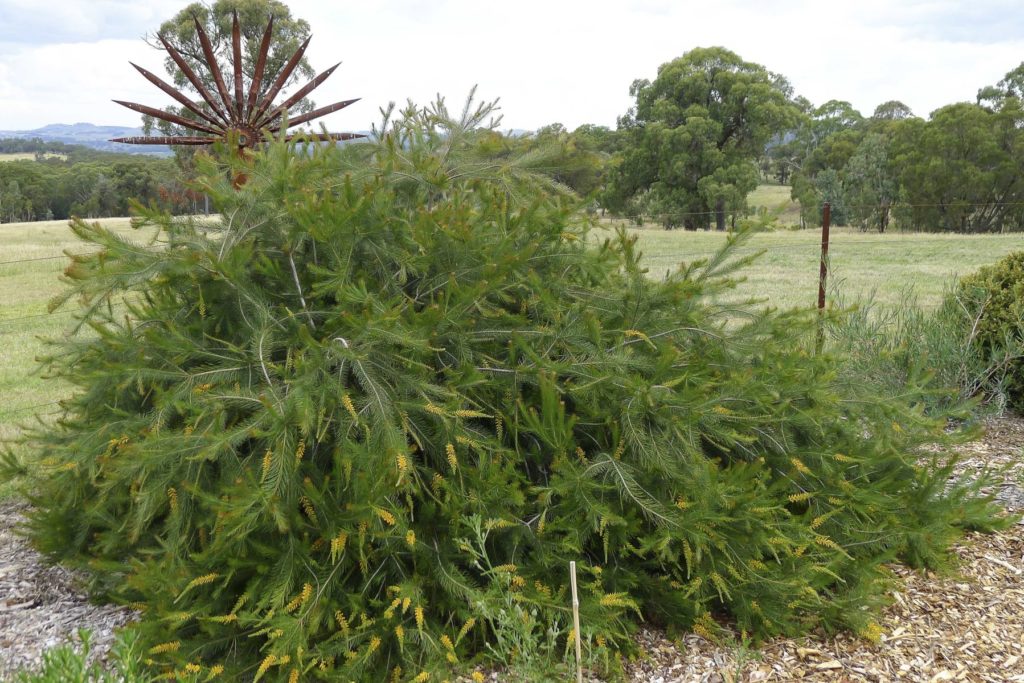
Chores for summer are pruning, weeding and removing plants past their use by date.
AUTUMN - a riot of orange, pink and purple
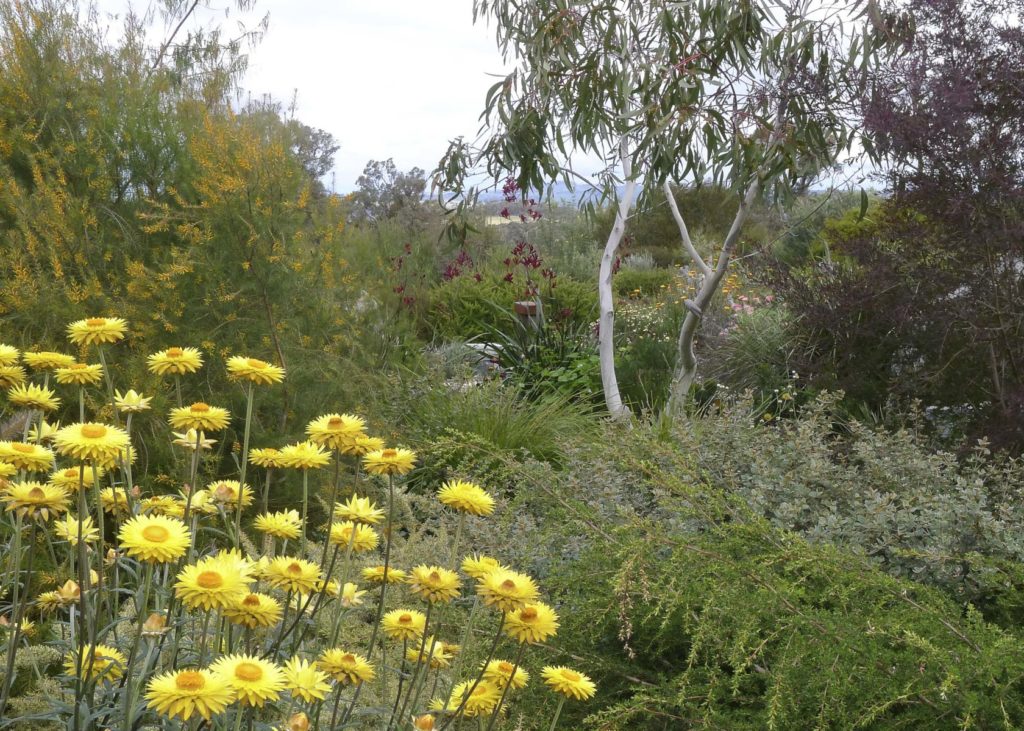
Summer ended dry and autumn started the same. Several large shrubs, including a promising Banksia serrata, were outcompeted for moisture by the nearby Eucalyptus macrorhyncha (red stringybark) and departed the garden. Luckily though, although dry, summer temperatures were not extreme and most of the garden managed well. April saw reasonable rainfall on the tablelands and the garden responded. The apples in the orchard are flourishing.
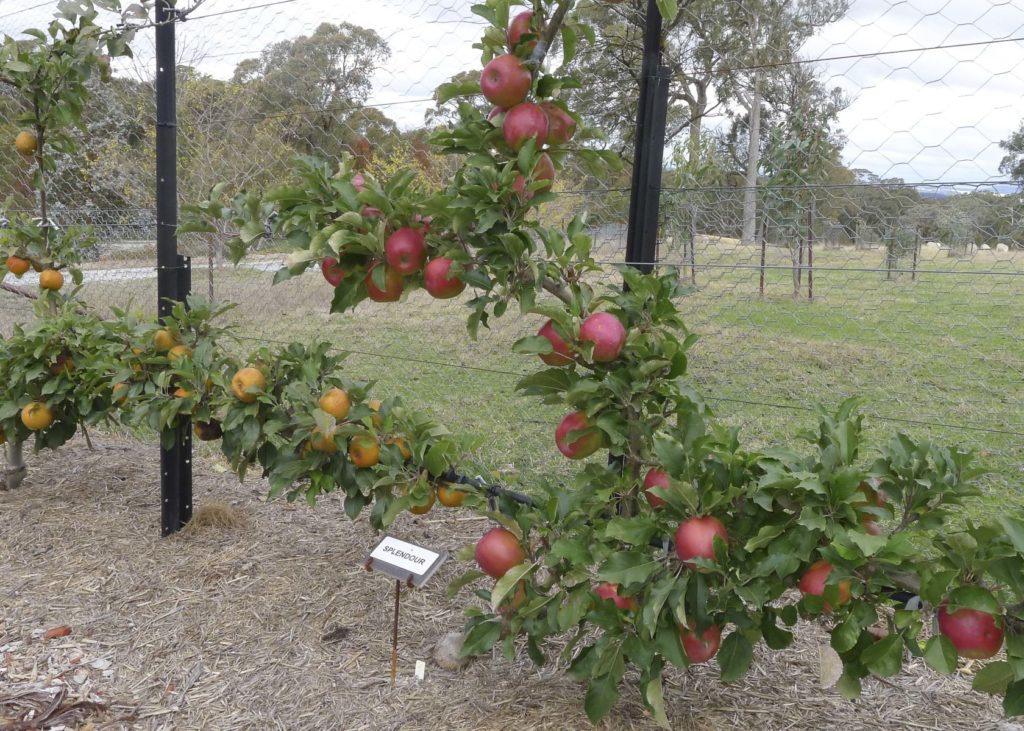
The banksias are lovely with a multitude of forms bursting into flower including Banksia spinulosa, Banksia ericifolia, my favourite Banksia paludosa ‘Green Cape Dwarf’ and the first ever flowers on Banksia conferta. The shrubby form of Banksia marginata marketed as ‘Bright Flowers’ was an absolute mass of small yellow flowers and bees.
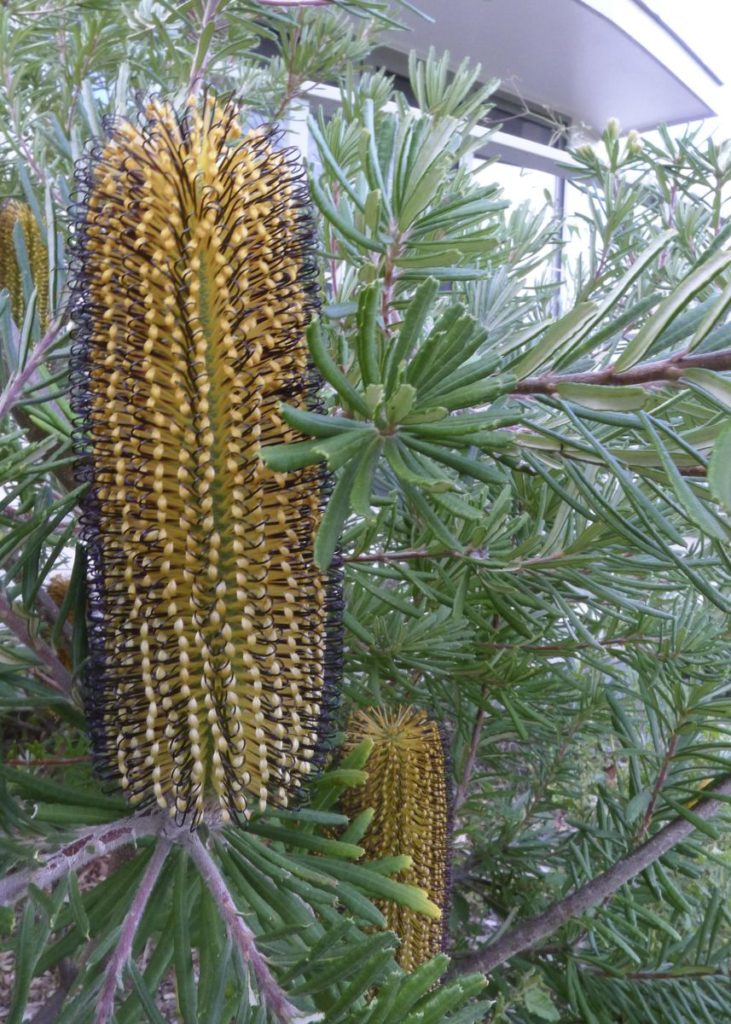
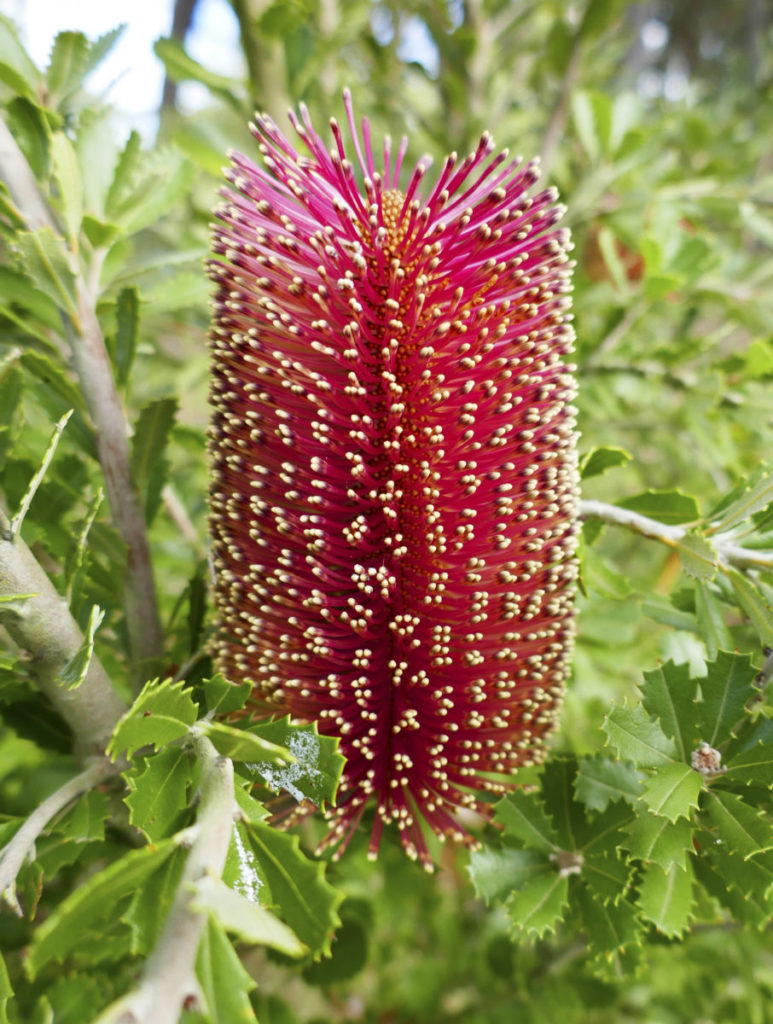
The croweas provide a stunning display and the Correa are in full cry. Lovely Prostanthera cryptandroides with its sticky, aromatic foliage is a picture and Eucalyptus gregsoniana (Wolgan Snow Gum) and a very young Eucalyptus orbifolia (Round-leaved Mallee) are making a nice display. The Eucalyptus orbifolia is just starting to develop its minni-ritchi-like bark.
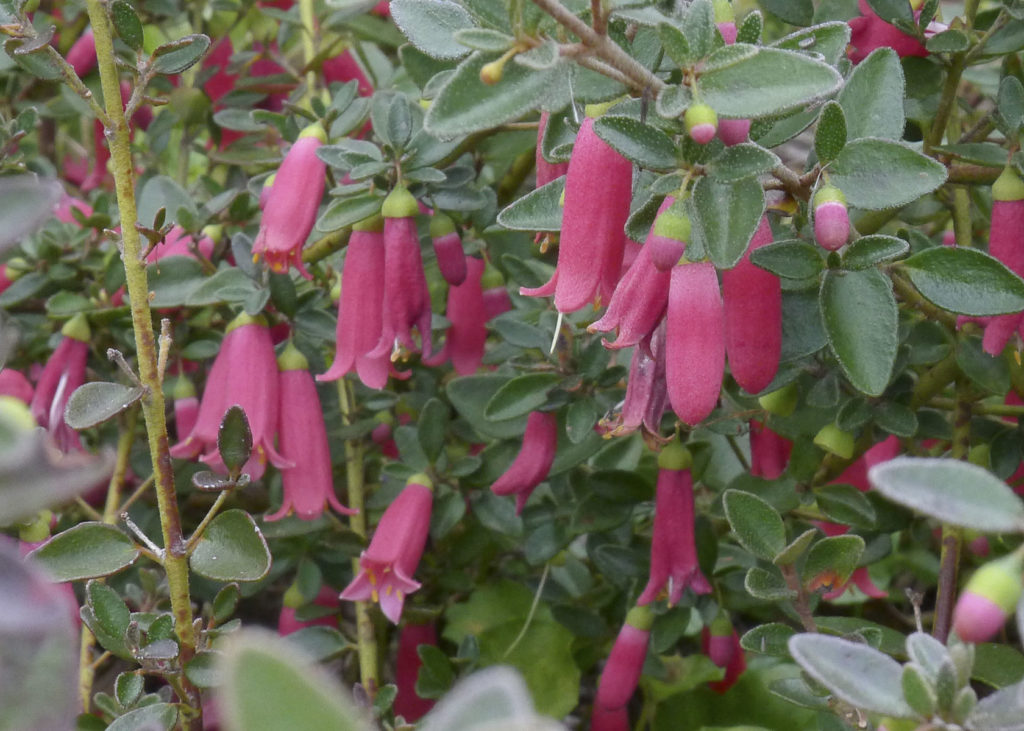
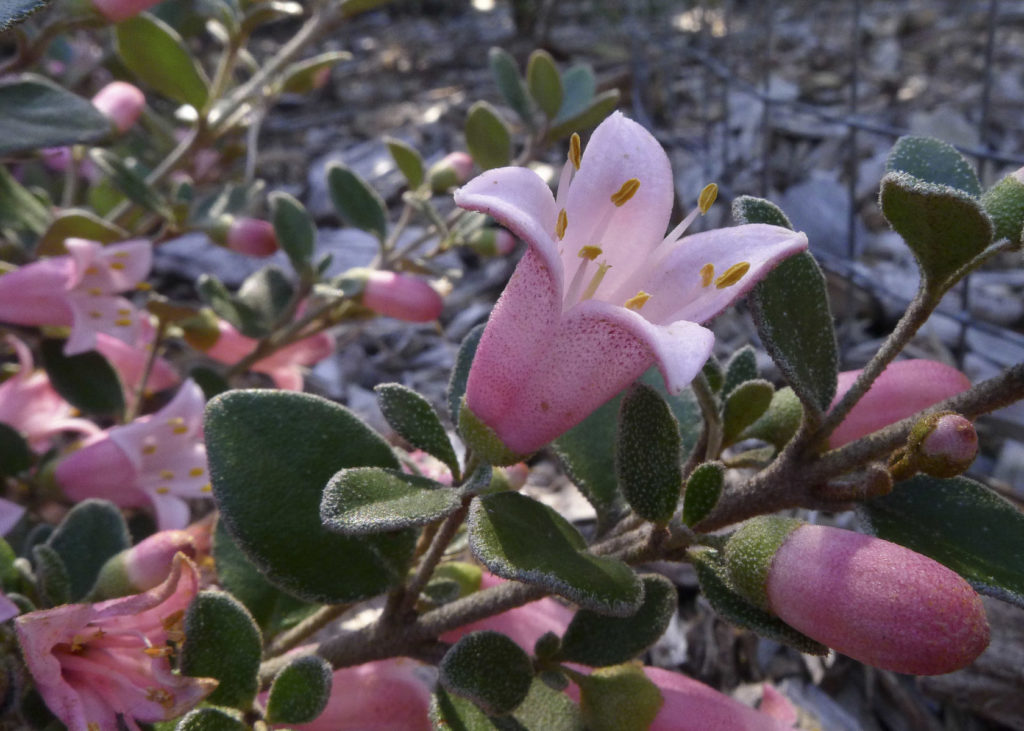
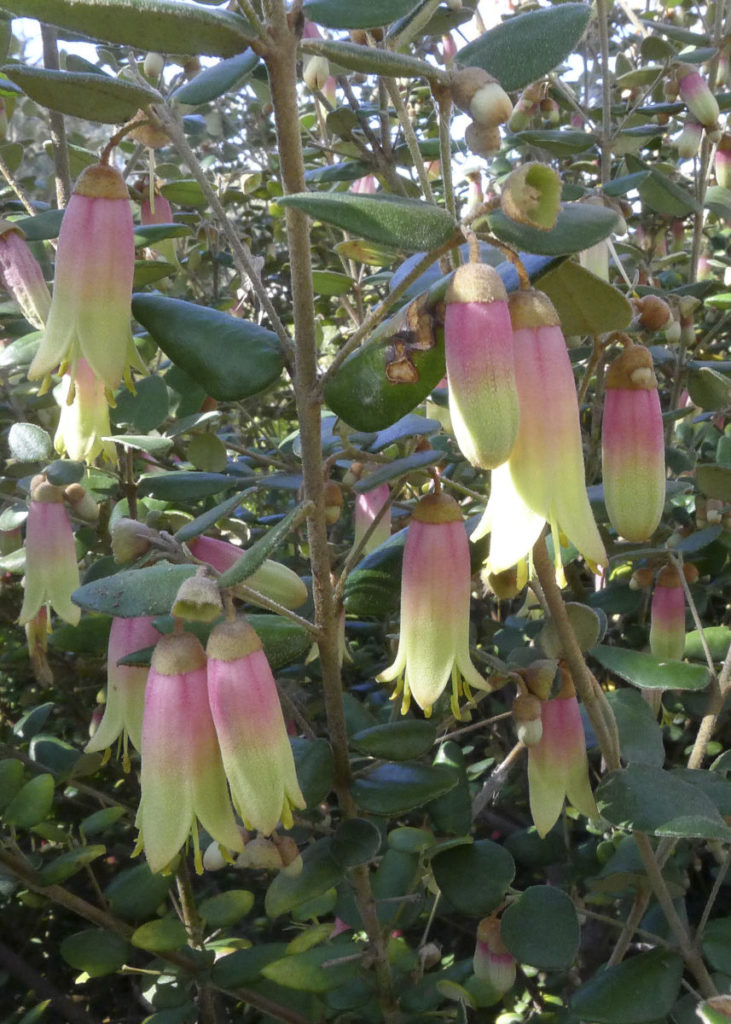
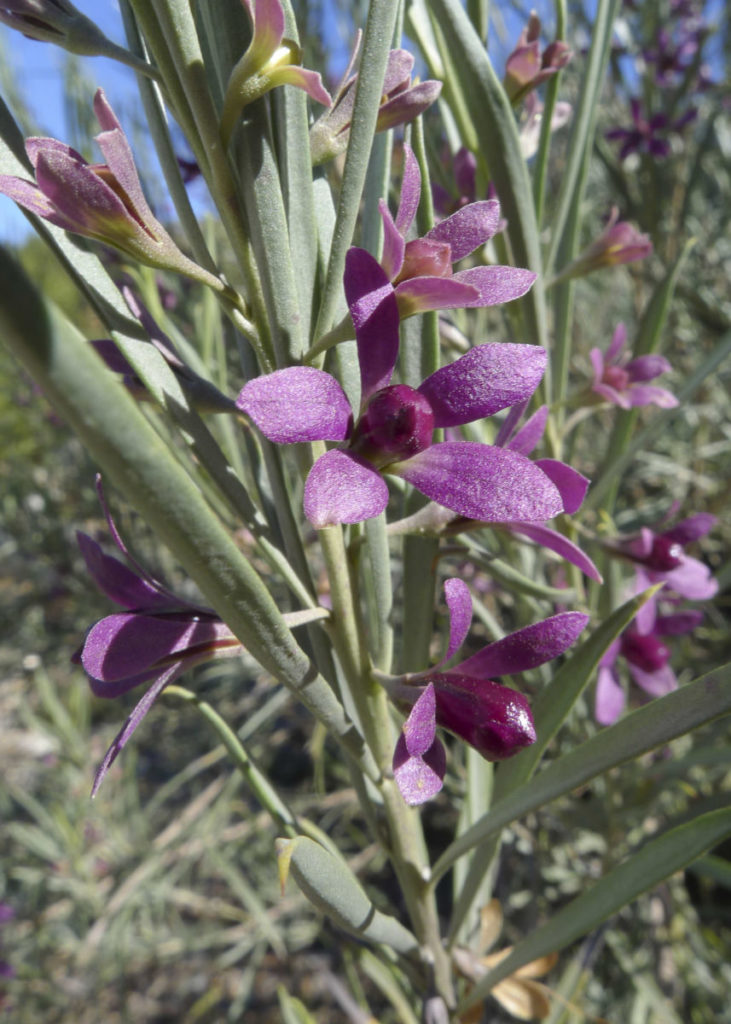
Leptospermum squarrosum (Peach-flowered Tea-tree) is in flower for the first time; all the flowers right down low in the middle of the shrub. This tea tree flowers in autumn on the old wood, unlike the majority which are spring flowerers on new wood. The purple-flowered form of Eremophila oppositifolia (Weeooka) appreciated the April rain and has budded up beautifully for a late flowering event, but the pink one has not. Why is this so? The large red Anigozanthos flavidus hybrids and the potted Chamelaucium uncinatum ‘Moulin Rouge’ have started flowering again.
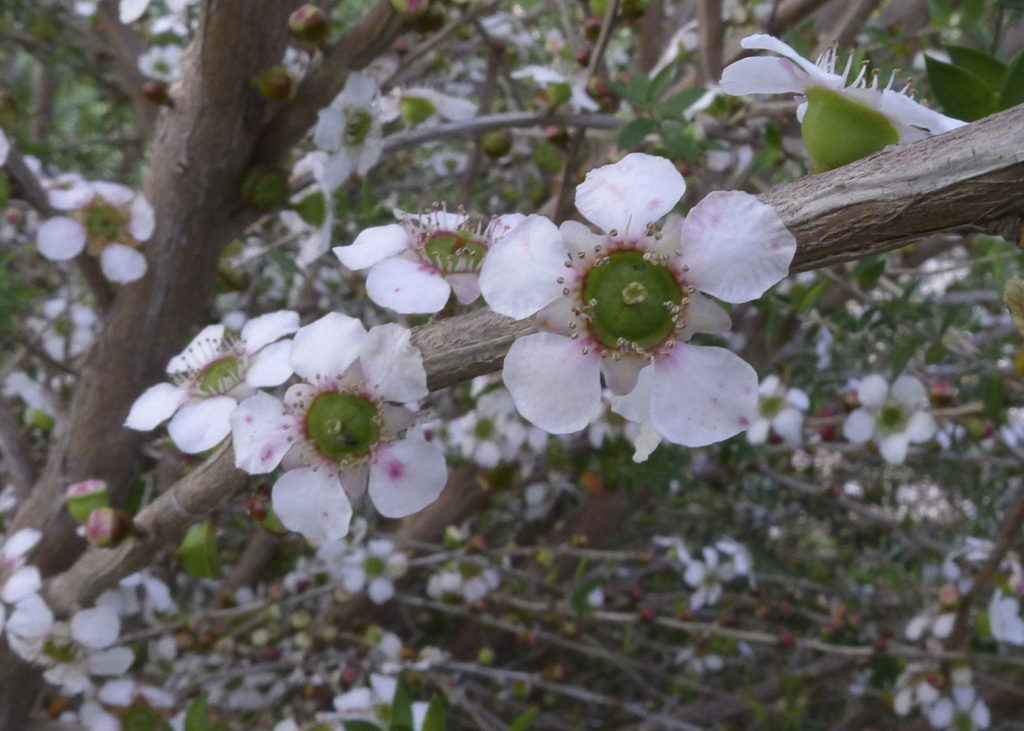
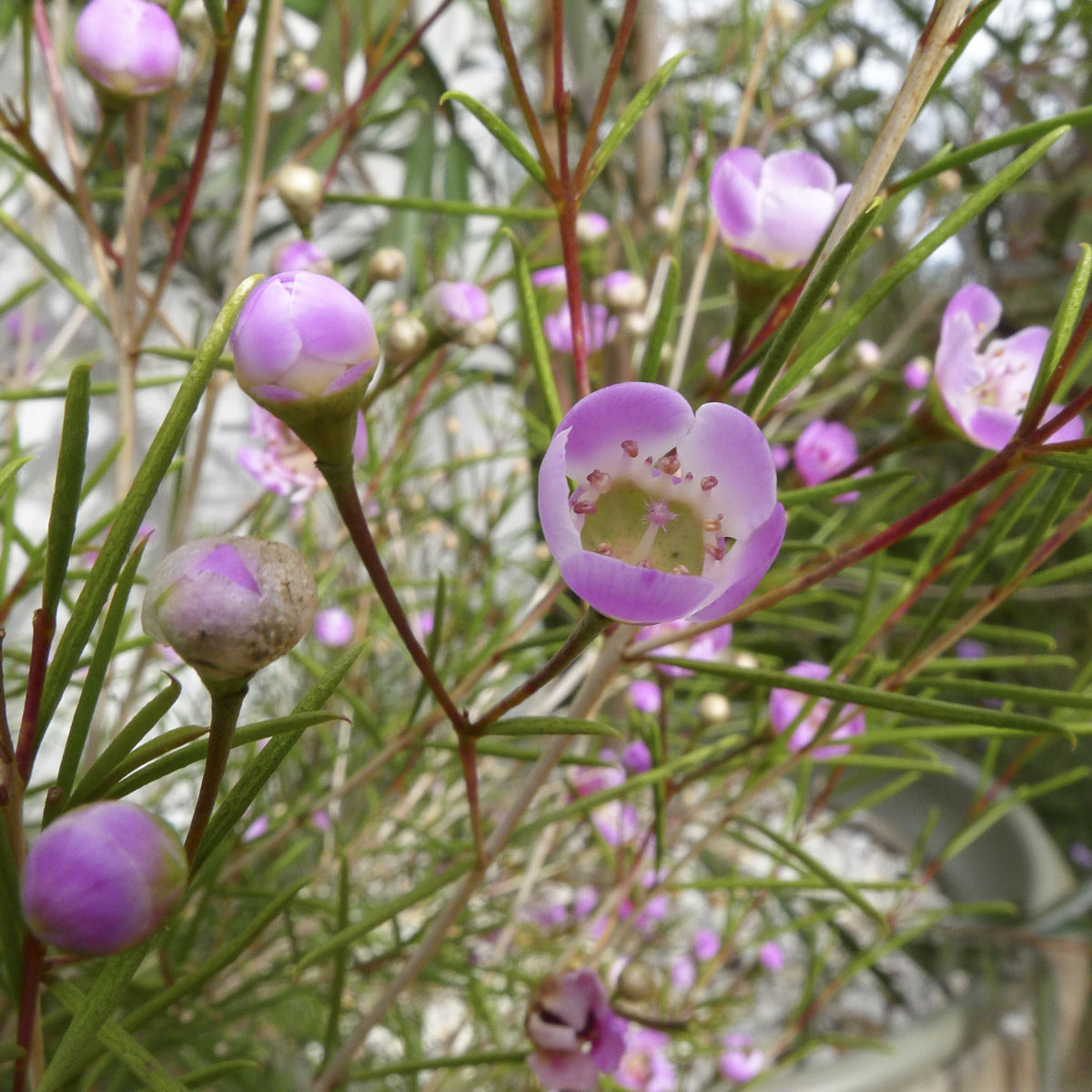
Underperforming plants are removed and unfortunately a lovely pink form of Alyogyne huegelii (lilac hibiscus) which became too large for its position, had to go. My imagination may be misleading, but I wonder if we missed out on autumn this year. It feels like we went straight from summer to the onset of winter. Where are all those lovely balmy days followed by crisp nights we look forward to so much? But perhaps they are still to happen…
WINTER – horizontal icy drizzle, then blankets of snow
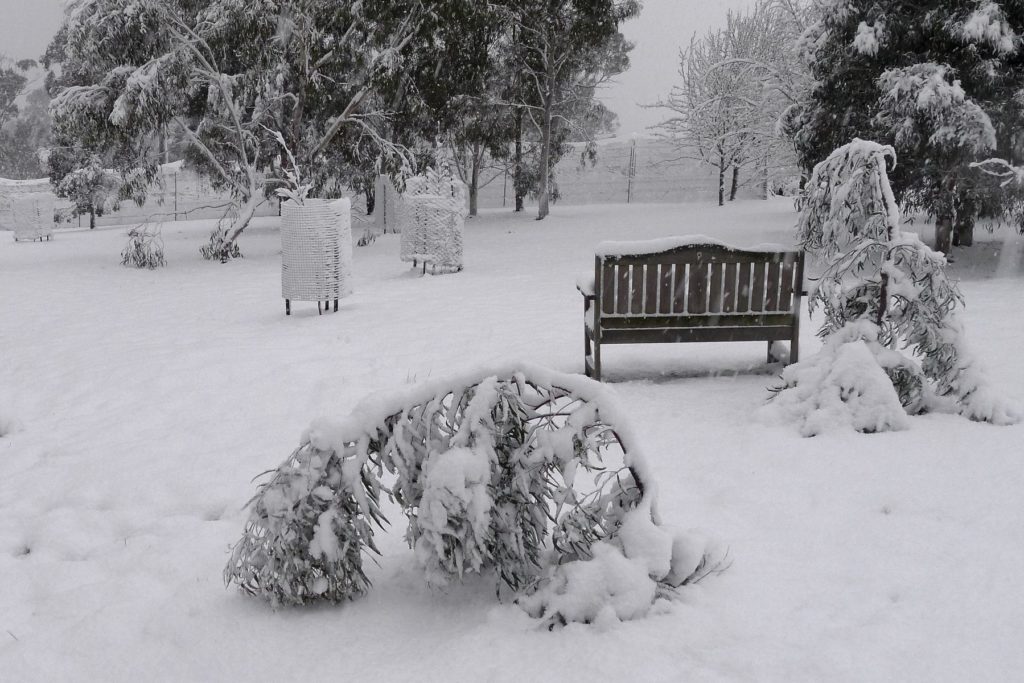
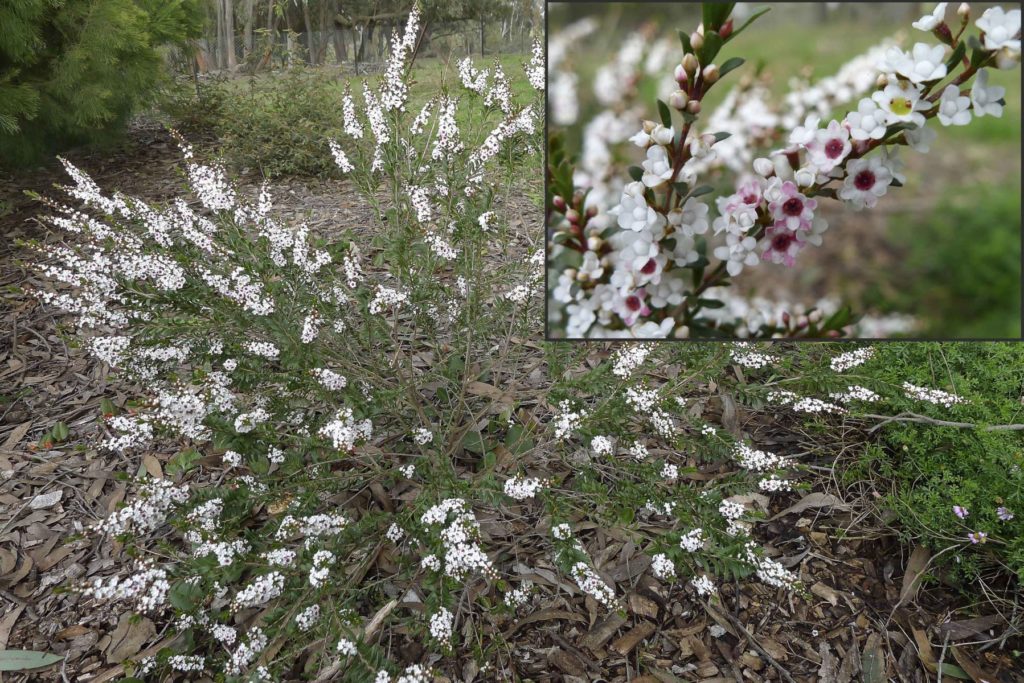
The late kangaroo paw flower stems collapsed with the first heavy frosts in June and are now just clumps of black leaves. These I will leave until early spring when I will cut them to the ground. Hopefully they will shoot away with the warmer weather and the eastern spinebills and I will once again enjoy their extraordinary flowers. The foliage of a beautiful grafted Grevillea petrophiloides looks less vibrant than it did and I suspect is on its way out. It was worth growing though even if it was for just one year, as the sight (from my favoured chair in the lounge room) of eastern spinebills swaying on the long thin flowering stems as they foraged in the pink flowers was just a delight.
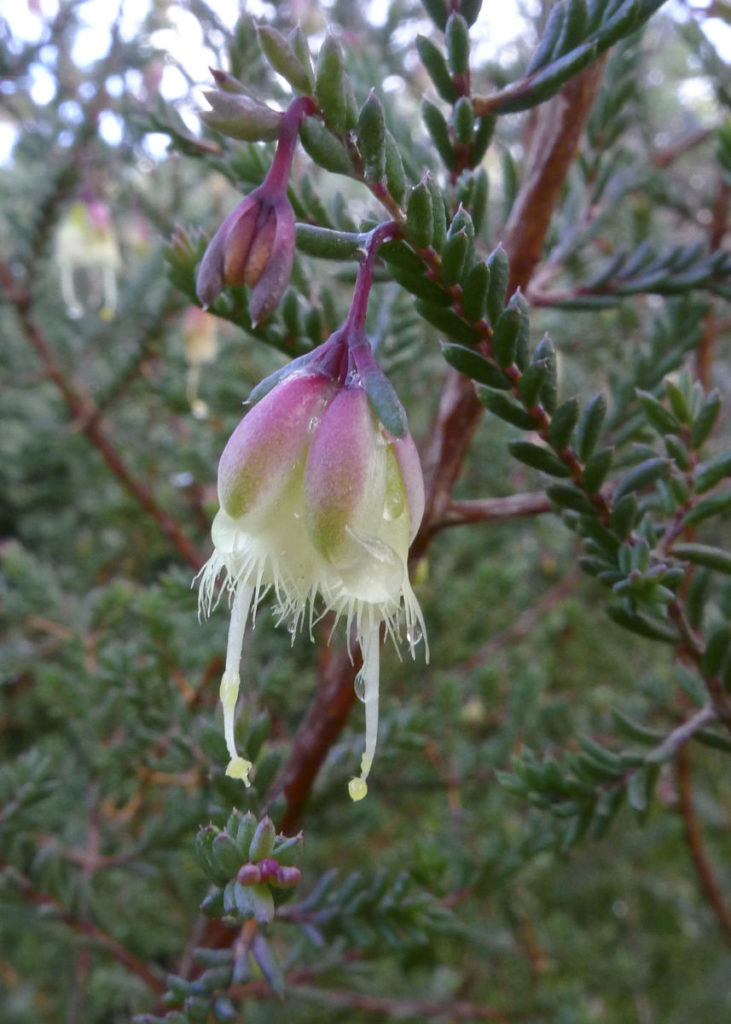
There are still flowers to be found, in addition to banksias, correas and croweas. Several Eremophila oppositifolia forms continue to put on a nice floral display although they, as well as Eremophila glabra, are starting to show the effects of the cold weather. Thryptomene calycina is definitely a winter-time favourite: dainty sprays of tiny white flowers. Myoporum montanum and Chamelaucium ciliatum are also displaying tiny white flowers now. Grevillea iaspicula and Grevillea lanigera are starting to flower well, and my poor battling Hakea laurina is showing off its very first blooms
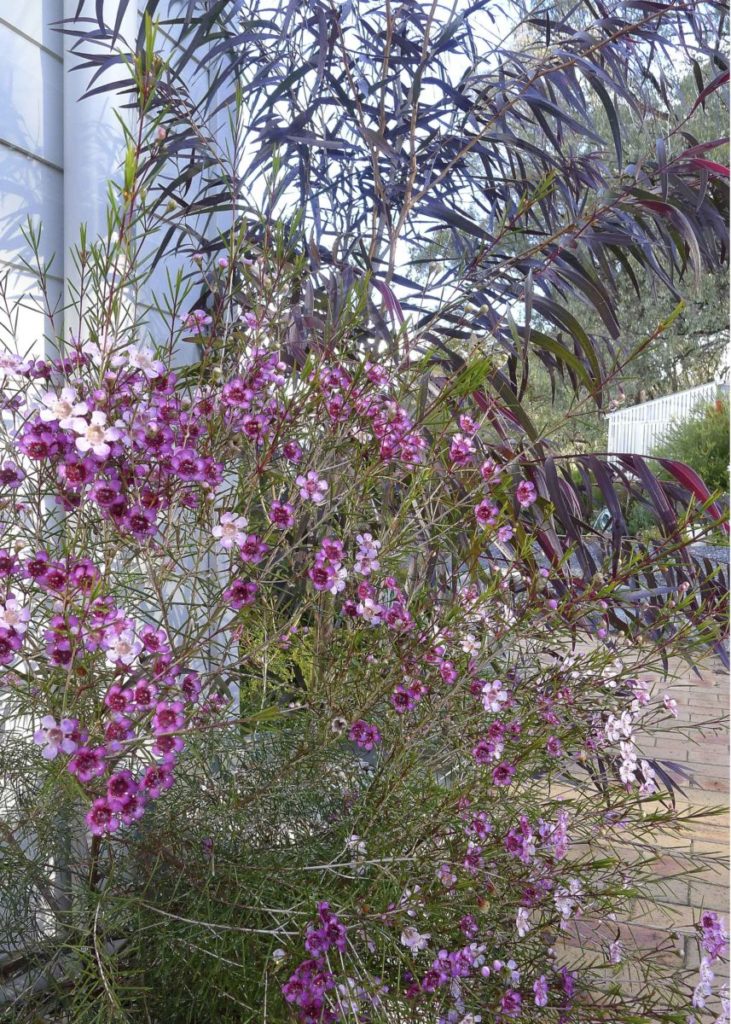
There are many plants that are attractive during winter without flowers. The foliage of Persoonia pinifolia and Persoonia oxycoccoides x nutans become a beautiful burnished burgundy bronze, with just the occasional tiny spark of a yellow flower to add a highlight. Another delight is the tracery of veins visible in the backlit foliage of Hakea petiolaris. A walk around the garden always produces something of interest to inspect. Pots of Chamelaucium ‘Moulin Rouge’ and Agonis flexuosa ‘Burgundy’ against the pale grey wall of the house make a lovely colour combination.
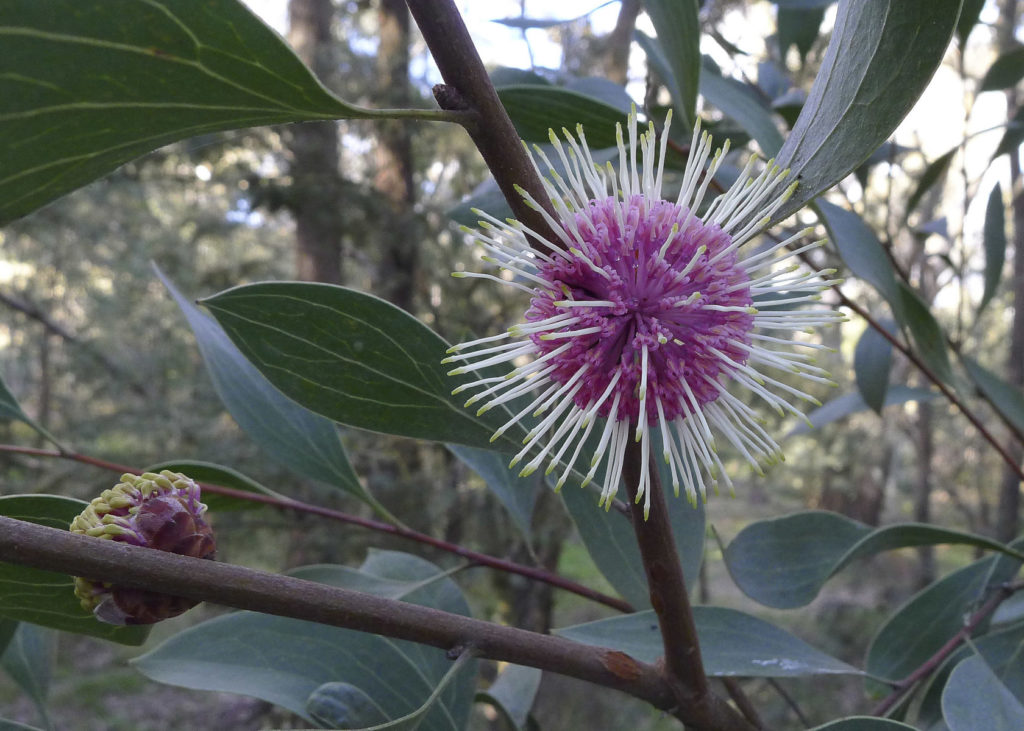
The small exotic cottage garden has been tidied up and most herbaceous plants cut to the ground – nothing is allowed to detract from the beautiful flowers and perfume of the Flowering Apricot! It started flowering in early June and will continue still for some time. Daffodil bulbs are starting to show through the soil but won’t flower for some months yet. The dwarf potted Meyer lemon carries more fruit on it than you could expect such a tiny bush to bear and the colourful fruit certainly brightens a grey day. Most work has stopped in the garden for the winter and I am itching to get out and do some. This is when my patience is really tested. A swamp wallaby has recently tried taking up residency in the garden. Today he’s hunkered down in the lee of a Dodonaea boroniifolia, looking miserable. Trouble is, he prefers the densest of places and breaks the plants in his travels. What to do?
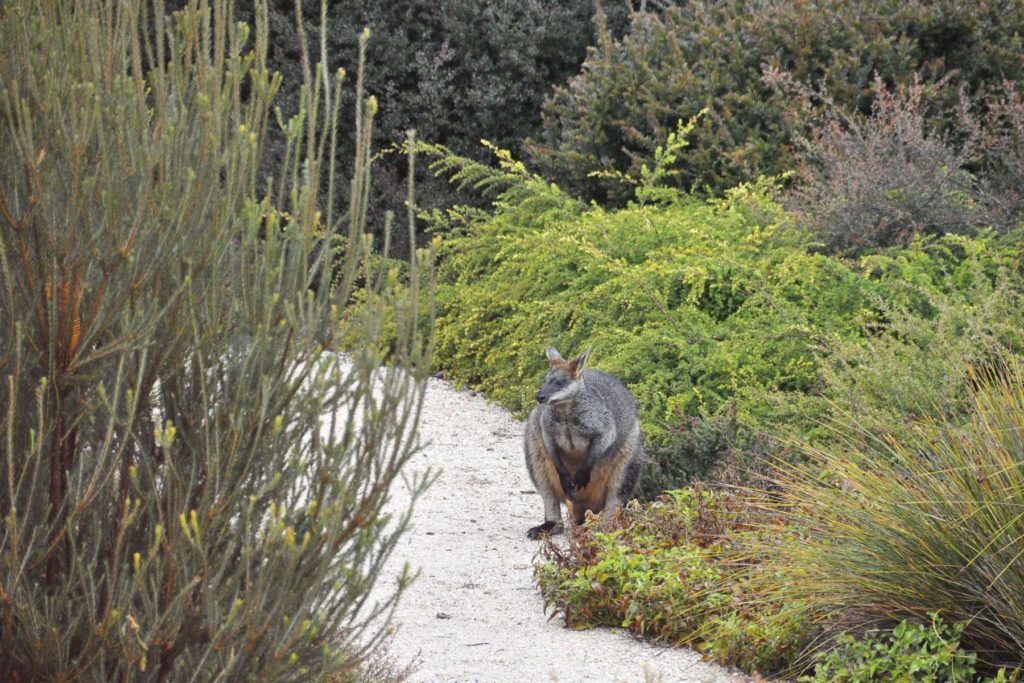
Our wallaby browser, image Fiona Johnson
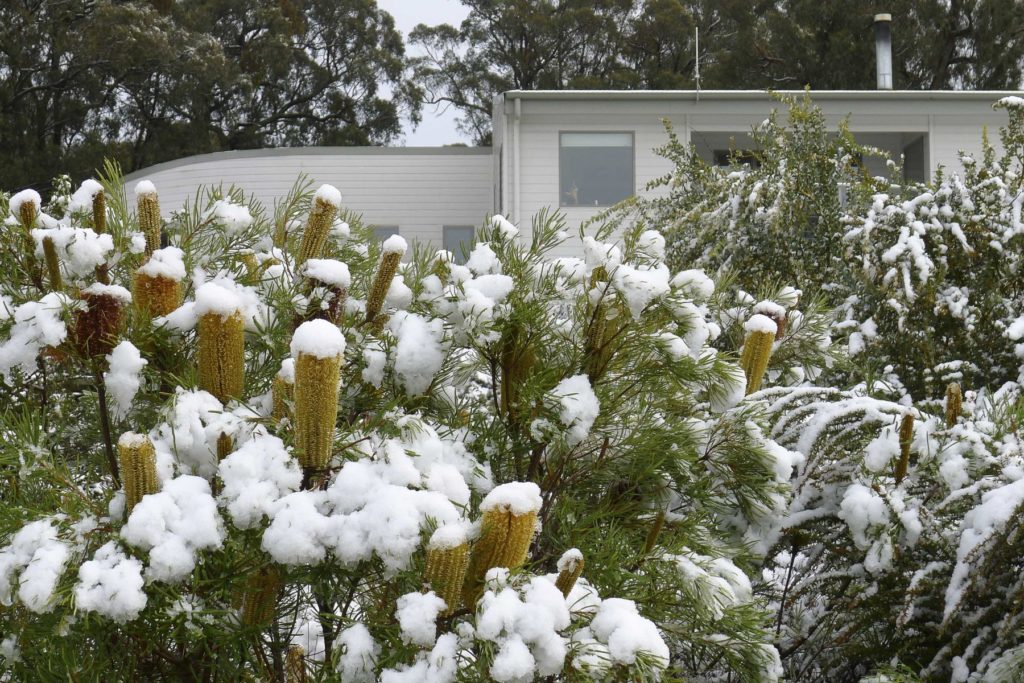
Another fall of snow, this time the most we have seen in years. The snow was beautiful and even now, three days later, there are patches in shady areas. Today I had a good look around the garden to see if there was any substantial damage. Not too bad really. A Prostanthera ovalifolia had fallen under the blanket of snow and snapped at the ground. An Acacia spectabilis has gone the same way. Some banksias were so heavy with flowers that they split, but should recover with some judicious pruning. Various tea trees and correas are still quite bowed over, even though the weight of the snow has been lifted. It amazes me how some trees can bend right to the ground and then, once the snow melts or falls, they apparently shake themselves off and stand upright again without any damage whatsoever.
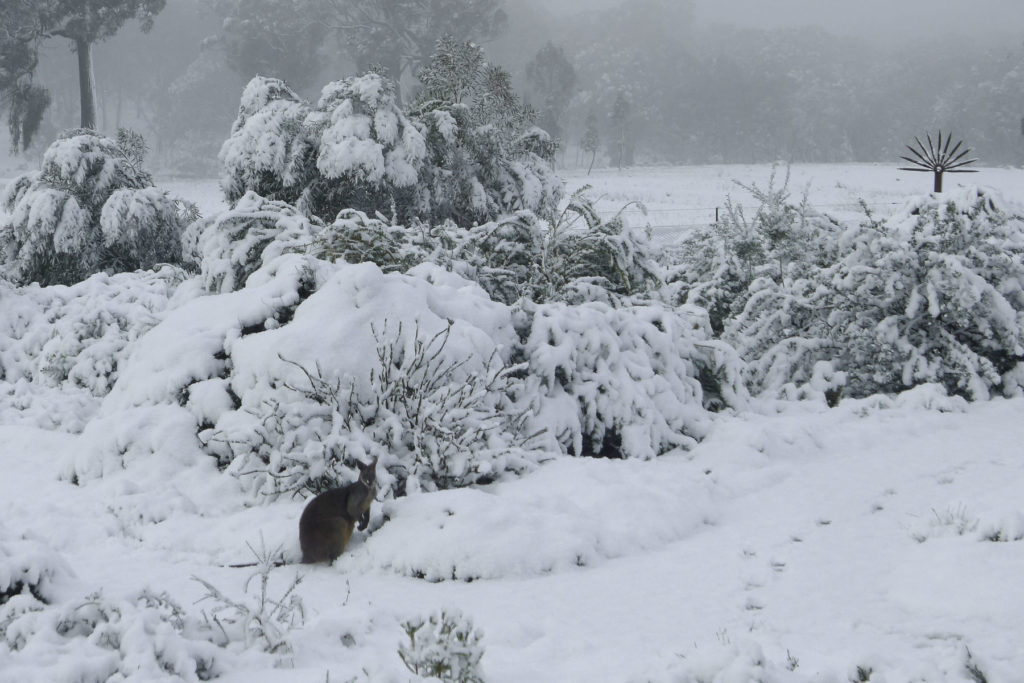
And the wallaby was back. We enjoyed watching him scraping away the snow to get at the foliage beneath. I let him stay on such a day! Now, we wait for spring again and the cycle to continue. Every year a new beginning.
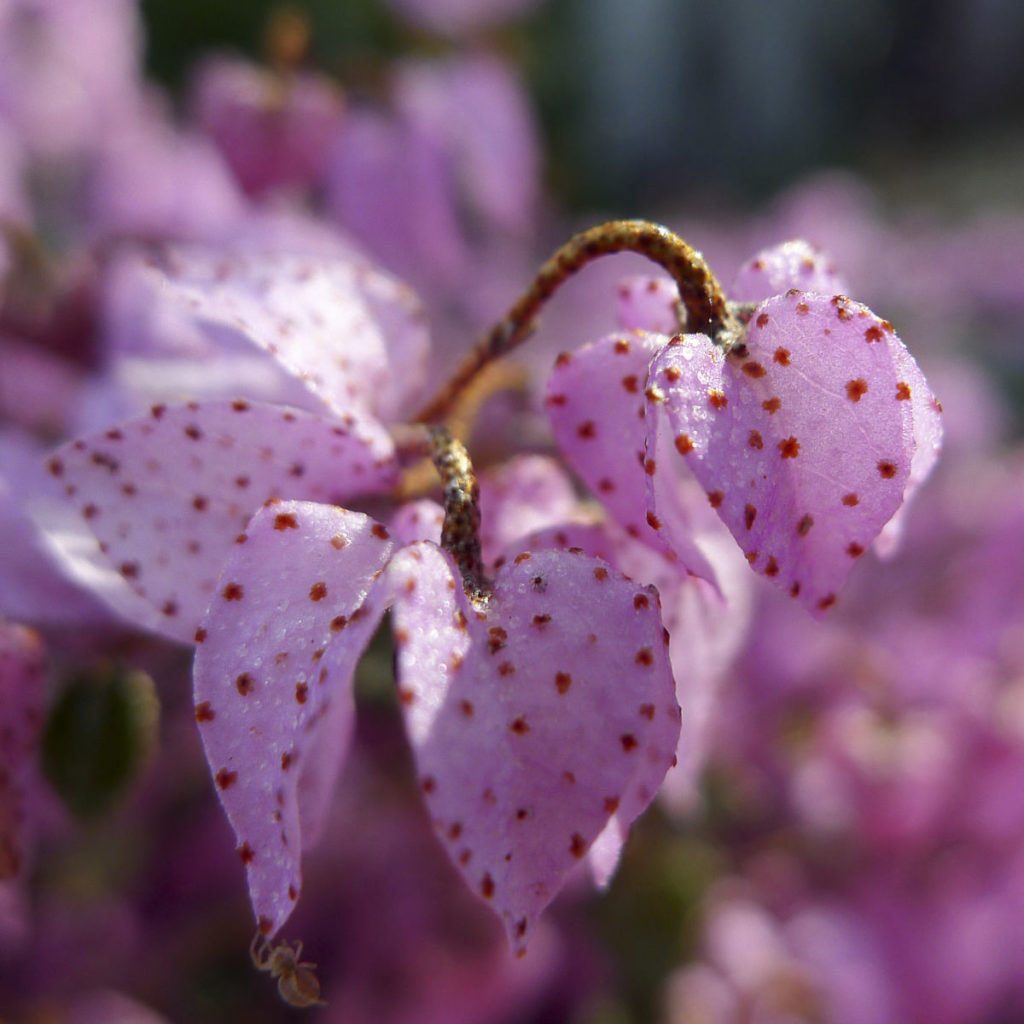
Story and images by Fiona Johnson, compiled by Heather Miles
This story first appeared in GardenDrum in July 2017.
